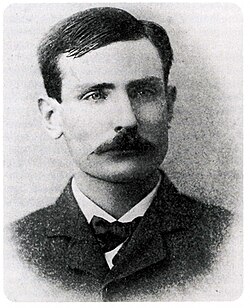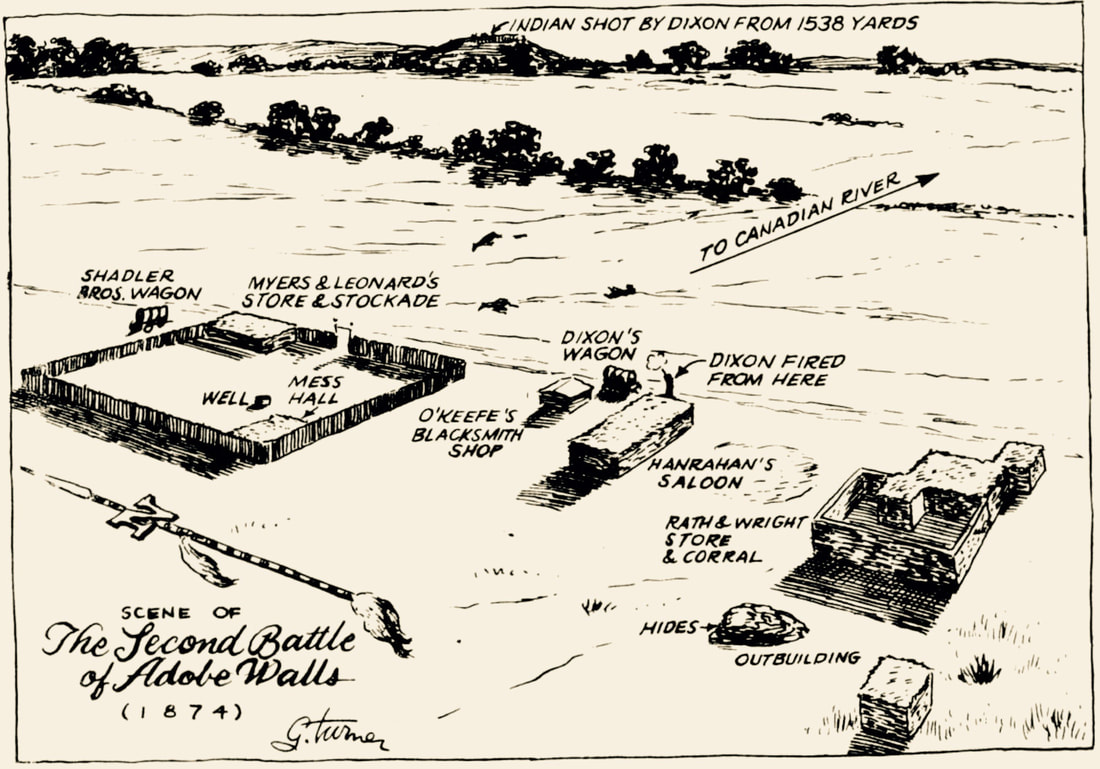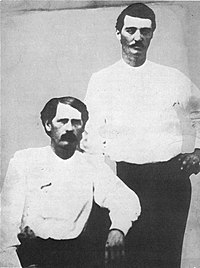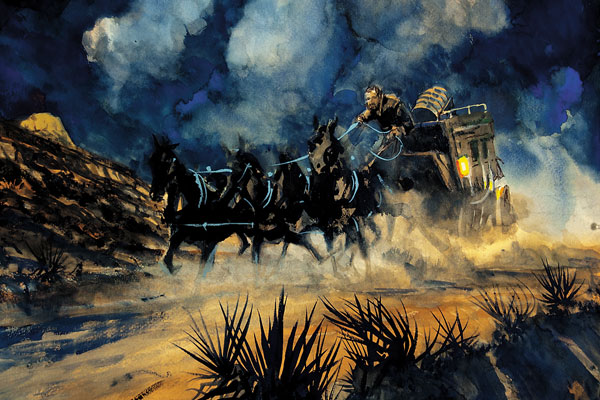
1879 - Bat At 26
Born to a Henryville, Quebec, Canada, Irish working-class family, Bat is the second child (there will be seven siblings altogether, three of whom will become lawmen) of Thomas Masterson and Catherine McGurk. Learning the outdoor skills that will become essential to his young survival on the plains of the Wild West, Bat toils on family farms in Quebec, New York, Illinois, Missouri, and Wichita, Kansas. As a teenager, Bat begins making a name for himself, along with brothers Ed and Jim, by becoming a buffalo hunter supplying meat to the men building the iron rails across the plains ... an occupation that dovetails nicely into Ed and Bat grading a five-mile section of track for the Atchison, Topeka & Santa Fe Railroad. When the pair aren't paid for the work, Bat spends a year tracking down the culprit, a subcontractor named Raymond Ritter, who becomes the first man to look down the barrel of Masterson's gun (forcing the man to part with $300 in wages before a cheering crowd of people at Dodge City's railroad depot). He will not be the last.
Hunting Buffalo

Ed Masterson

Jim Masterson
In the years that follow, Bat will be one of the hunters (28 in all) that fight off a five day siege of hundreds of Comanche, Kiowa, and Cheyenne warriors, led by Quanah Parker at the 1874, Second Battle of Adobe Wars (the buffalo hunters lose only four men, the Indians between fifty and seventy, and the clash ends when hunter William "Billy" Dixon brings down a warrior with his Sharps rifle from almost a mile away). As a U.S. Army scout for Colonel Nelson Appleton Miles (who will force the surrender of Chief Joseph and his Nez Perce in Montana, and the capture of Chiricahua Apache, Geronimo, in 1886, rising to eventually command the entire U.S. Army), Bat will be one of the scouts that rescues four young white sisters (their parents and older siblings slaughtered crossing the plains on their way into Colorado) from a raiding party of Cheyenne Dog Soldiers. First notch earned, after arguing over a card game, Bat kills Corporal Melvin A. King of the 4th Cavalry in Sweetwater, Texas in 1876, helped immensely by dancehall girl, Mollie Brennan, taking the bullet meant for Bat ... wounded in the pelvis (he will take eight weeks to recover and will begin using the cane he will become famous for carrying), Masterson will draw his pistol as he is falling and kill King with a single bullet through the horseman's heart.

Parker

Adobe Flats Layout

Miles
After experiencing a pistol whipping when he tries to prevent the arrest of a Dodge City friend, Bat decides to become a lawman himself and accepts an appointment from Sheriff Charles E. Bassett, then successfully runs for office (winning by the narrow margin of three votes) at the same time that his big brother Ed becomes the city marshal (but not for long, trying to disarm a drunken cowboy named Jack Wagner, 25-year-old Ed is mortally wounded in the right side ... a killing that is almost instantly avenged when shots from Bat kill Wagner, and wound his boss, Art Walker, in the lung and arm). Ed out (before his death, the two brothers capture the notorious outlaws, Dave Rudabaugh and Ed West in February of 1878), Bassett back in, the new town marshal will hire Jim Masterson as a deputy marshal (he will in turn replace Bassett in 1879) along with a friend from the men's buffalo hunting days, Wyatt Earp. On October 4, 1878, as a member of the posse pursuing James Kennedy, for the killing of a variety actress named Dora Hand, it is a Bat bullet that brings the fleeing killer off his horse and into the captivity of the Dodge City jail (assisted by Wyatt Earp and Bill Tilghman). Supporting his former employers with the Santa Fe Railroad, in 1879, Bat recruits a group of gunmen to battle against the Denver & Rio Grande Western Railroad over the right-of-way through the Royal Gorge of Colorado ... among the notorious gunmen are Ben Thompson, "Mysterious Dave" Mather, Doc Holliday, and John Joshua Webb. Despite the firepower provided, Bat's involvement in the Royal Gorge Railroad War ends when he and his men are forced to surrender a Canon City roundhouse they are holding in June of 1879 ... a defeat which bites Bat again when he loses his re-election bid to remain the Ford County sheriff, losing to a local bartender named George T. Hinkel by a vote total of 404 to 268.

Wyatt & Bat In Dodge City - 1876

Royal Gorge Railroading
Out of a job, but not out of gun work, at the telegram request of his friend, Ben Thompson, Bat saves Ben's brother, Billy, from a lynching in Ogallala, Nebraska and gets him safely back to Dodge City with the assistance of another frontier pal, William Frederick "Buffalo Bill" Cody (who provides a place to hide and transportation over the plains to the cow town). And then he receives another telegram to help another friend ... Wyatt Earp could use an assist in making the mining camp of Tombstone, Arizona into a peaceful town (offering the gunfighter a job dealing faro and providing security for the Oriental Saloon, a job gunfighter Luke Short also accepts). Off to Arizona for a brief sojourn that lasts only two months, Bat pitches in with the peace keeping, finding himself alongside Wyatt and Morgan Earp, on a posse organized by Deputy U.S. Marshal Virgil Earp that goes after a group of Cowboys that have killed driver Eli "Bud" Philpott and passenger Peter Roerig attempting to rob the Benson to Tombstone stagecoach at a point along the San Pedro River called Drew's Station. The pursuit of the crooks a failure, when Tombstone Sheriff Johnny Behan neglects to provide the posse with fresh mounts and supplies, Wyatt and Bat, without water for thirty-six hours, leave their exhausted mounts on the trail and walk eighteen miles into Tombstone. There, intending to recover from his posse ordeal, Bat instead becomes the recipient of yet one more telegram requesting his help, this time from an anonymous sender in Dodge City stating, "Come at once. Updegraff and Peacock are going to kill Jim" (and that might have indeed happened, days earlier someone has taken three shots at Jim as he walked the city's streets at night). Recognizing Peacock as Jim's partner in the Lady Gay Dance Hall and Saloon and Updegraff as the brother-in-law bartender (a drunk who has helped himself to the saloons profits) of Peacock, Bat sets off on a stage and railroad trip of over 1,100 miles that takes him to Benson, through New Mexico, into Colorado, and then eastward across Kansas to Dodge City. He arrives at the Dodge City Depot at around noon on April 16, 1881.

Cody
Tombstone
Luke Short

Away From The Attempted Robbery
Inside The Lady Gay
Nervous he has arrived too late to help his brother and wary of the reception that might be awaiting his arrival, Bat steps off the train with perfect timing ... as the train he arrived on pulls out of the station, it reveals two men standing together on the other side of the tracks, the men Bat has come to see, Peacock and Updegraff. Facing the armed men, hands poised beside the ivory-handled grips of his pistols, Bat calls out, "Hold on. I want to talk to you. I have come over a thousand miles to settle this. I know you are heeled-bow fight!" Instead, the men flee, pulling their pistols and firing on Masterson as he advances towards their position behind a corner of the city jail. Pulling his pistols, Bat returns fire as he crouches in a three-foot deep railroad embankment. Volume over accuracy, the muddy streets around the depot (there has been an early spring rain the day before) clear of civilians as the men fire away at each other, breaking windows with their bullets and blowing holes into the facades of the city's downtown wooden structures (across from the tracks, Dr. McCarty's drugstore takes a pounding, as does the Long Branch Saloon, its owner takes refuge behind the steel bulk of the establishment's safe as a nearby idler has the paper he is reading shot out of his hands).

Downtown Dodge City
The Jail

Inside The Long Branch
Soon, supporters of Peacock and Updegraff also begin firing on Masterson (one bit of lead kicks near-miss dirt into Bat's mouth, then ricochets away, wounding bystander James Anderson in the back as the man flees the area), then, slugs of Bat's friends begin arriving from the north side of town (some sent Peacock's and Updegraff's way from the pistols of Jim Masterson). For about four minutes bullets fly all about the plaza, then, at almost the same time, Bat and Peacock run out of ammo in their weapons, and Updegraff goes down from a slug in his right lung (no one knows who to credit for the hit). About to reload and continue the fight, Bat decides instead to surrender when newly elected Mayor Abe Webster and Sheriff Fred Singer arrive on the scene brandishing buckshot loaded shotguns, one of which is pushed into Bat's back as Webster tells Masterson his brother is alive and leads the arrested gunman off to the jail. It is the last gunfight in which Bat will ever participate.

Downtown Businesses

Webster
Singer
Later that afternoon, a hearing on the battle takes place in which Bat is fined eight dollars for discharging his weapon within the city limits, and since it is determined that Updegraff will survive his chest wound, the two Masterson brothers are allowed to leave town once Jim allows Peacock to buy out his shares in the Lady Gay. Battle and aftermath survived, the two men will go on to other adventures. Jim will join the police force of Trinidad, Colorado, become the under sheriff for Colfax County, New Mexico, take an active part in the 1889 Gray County War in Kansas (a conflict over whether the city of Cimarron or Ingalls will become the official county seat), leading the lawman that take over the Cimarron courthouse during the Battle of Cimarron (one man will be killed and seven wounded in the clash), becomes the deputy Sheriff of Logan County, Oklahoma, and as a Special Deputy U.S. Marshal, leads the lawmen who try to breakup the Doolin-Dalton Gang during the Battle of Ingalls (Masterson will famously capture "Arkansas Tom" Jones by threaten to pitch dynamite into the hotel hiding place of the outlaw). He dies in Guthrie, Oklahoma in 1895 from tuberculosis at the age of 39.

Cimarron Courthouse
As for Bat, though he won't pull his pistols in anger ever again, he is a busy man over his last four decades on the planet. In 1892, at a salary of $75-a-month (supplemented by his dealing faro at night), Bat becomes City Marshal of Trinidad, helps out (along with others) Luke Short when the gambler/gunfighter is kicked out of Dodge City during what is called the Dodge City War, moves to Denver and begins a career in journalism (along with owning the Palace Variety Theater), begins a long-term friendship with the infamous Wild West conman, Jefferson Randolph "Soapy" Smith II, takes in several heavyweight prize fights sometimes serving as a second or timekeeper in the bouts, manages the Denver Exchange gambling Hall in the silver mining camp of Creede, Colorado, serves as the deputy sheriff of Arapahoe County, Colorado, and finally moves to New York City where he serves as the bodyguard for millionaire George Gould, becomes a columnist for the NewYork Morning Telegraph, is appointed deputy U.S. marshal for the southern district of New York (earning $2,000 a year) by his friend, President Theodore Roosevelt, and finally dies while seated at his desk writing an article for the Telegraph as a result of a massive heart attack that claims the famous gunman at the age of 67 on October 25, 1921 (over 500 people attend his funeral and his honorary pallbearers include legendary boxing promoter George "Tex" Rickard, writer Damon Runyon, and Telegraph owner, William Lewis. He is buried at the Woodlawn Cemetery in the Bronx, but really never leaves the consciousness of the American public, his adventures (real and imagined) serving as entertainments in books, magazines, songs, movies, and on television (immortalized by actor Gene Barry in Bat Masterson, an NBC show which run for 108 episodes from October 8, 1958 to June 1, 1961).

In New York - 1911

Barry As Masterson

The Real McCoy
No comments:
Post a Comment